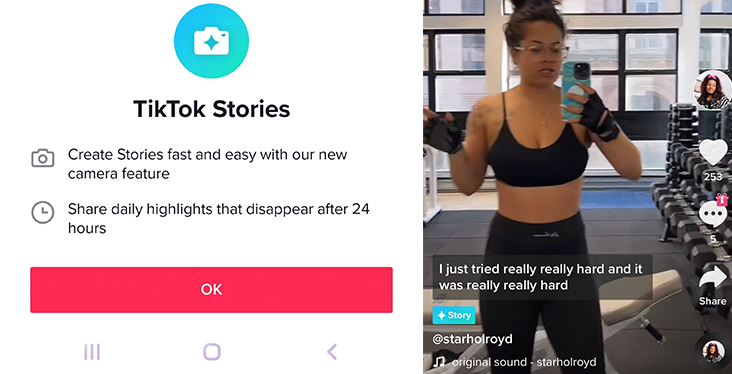
Get a public profile to run ads on Snap
From June 2022, you’ll have to set up a free public profile if you want to run ads on Snapchat.
Snapchat public profiles are the first organic presence for a brand or business on Snapchat, which shows the importance of organic content for brands. With a public profile, brands can share public Stories, showcase branded Lens experiences and share shoppable products.
This is complimentary to advertising on Snapchat, providing audience insights and custom audience segments using on-platform actions.
Viewers subscribe to public profiles to stay up-to-date on all posts via their Subscription carousel. Non-subscribers can find this content within the Discover section or in Spotlight.
So the upshot of all this is… you need to set up an account, if you haven’t already. And you should – organic content works well on the platform.
But it’s important that brands strategise how they present themselves organically on the platform, and that’s something we can help you with. Get in touch!

TikTok Stories are here
The testing is over. TikTok Stories – the platform’s 24 hour ephemeral content feature – is being properly rolled out.
Users can edit new or existing pictures or videos with effects, text and audio to create a Story, which can be viewed via the user’s profile image – which, similar to Instagram, will feature a blue ring when the they post a Story.
For brands, Stories offer a whole new way to engage with their TikTok community. It’s a chance to share those off-the-cuff unpolished moments – like snippets from day-to-day life or behind the scenes of a new product launch – that can humanise a brand.
Expect Stories to get ad integration too. It’s an opportunity for advertisers to reach their audiences using a new format that keeps users scrolling through content for longer.

Twitter Shops now in live testing
What’s the difference between Twitter’s Shop module and the new ‘Twitter Shops’? Well, quite a lot, actually. While the former allows merchants to showcase up to five products on their profile, Twitter Shops goes up to 50.
Here’s how it works: Shoppers browse and purchase items within a merchant’s Shop by clicking the ‘View shop’ button on their profile. Product listings then redirect to an in-app browser with further product information and a checkout page via the merchant’s website.
Twitter Shops is free to use and available to select US-based merchants, and shoppers on iOS in the US can browse products on Twitter Shops. Over time, this should be rolled out to more merchants and countries, and the maximum number of products may be increased, too.
Brands can use Twitter Shops to curate an audience-specific product catalogue and cater to all stages of the purchase journey by providing a point of action where a conversation becomes a purchase.

Play tag, and convert discovery into purchase
For the first time, any Instagram user will be able to tag products in their post – not just those with business or creator accounts. In the post editor, use the ‘Tag people’ button, tap the product in your photo or video and search for the product to add a tag.
Other users will see the product tags in your post and can tap them to make a purchase, and brands will get a notification when they’ve been tagged.
This is a great way of expanding product visibility through organic, non-sponsored posts and broadens opportunities for product sharing on Instagram beyond creators. It’s basically free advertising, and because it’s come from ‘real’ people, lends serious credibility.
And it’s really taking off. Instagram says 1.6 million users tag at least one brand every week. Instagram wants to become the go-to place for trend and product discovery – which in turn could lead to purchase.
Right now, this feature is for US users only, but within months everyone should be able to tag away to their heart’s content.

What’s new with Pinterest’s shopping features?
Let’s bring you up to speed. First of all, there’s the Your Shop feature – an in-app shopping page displaying brands and products curated to users’ own tastes – while
Pinterest has looked to streamline the purchase process by adding an in-app checkout page for Shopify merchants. With Pinterest being a place users go to for inspiration – and often with purchase intent already top of mind – this streamlined experience means Pinners can get inspired, browse products they’ll be interested in, and purchase, all without leaving the app. These features are in beta in the US, with a wider rollout expected later in the year.
Next up, there’s an improved Shopping API for simplified product catalogue connection and in-depth data and filters for the Pinterest Trends tool, which is available now in the US, UK and Canada. This will help merchants sync their product catalogue with what they’re showcasing on Pinterest. For example, the API ensures product Pins reflect updates in real time, such as sold out products.
With values-based shopping on the up as consumers vote with their wallets via responsible, ethically sourced or local businesses, the new ‘Merchant details’ feature will allow businesses to display badges on their profiles calling out the brand values and communities they represent. These include eco-friendly, woman-owned, LGBTQ-owned, responsibly-sourced and inclusive. Merchant details help brands stand out, with a 16% increased chance of making a sale.
And last but not least, advertisers will soon be able to create sponsored Idea Pins and Idea ads, giving them the opportunity to reach wider audiences and highlight key paid partnerships with platform creators.
We’re experts in creating content for Pinterest, so get in touch and let us help with your next campaign.